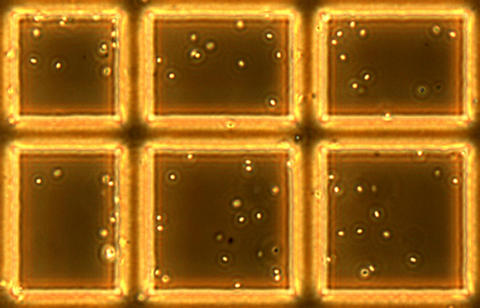
Anthrax bacillus spores viewed under a microscope in a cell chamber to measure concentration.
Researchers from the National Institute of Standards and Technology (NIST) and the U.S. Army Dugway (Utah) Proving Ground have developed reliable methods based on DNA analysis to assess the concentration and viability of anthrax spores after prolonged storage. The techniques and data are essential steps in developing a reliable reference standard for anthrax detection and decontamination.
Bacillus anthracis, the bacterium that causes anthrax, has been a centuries-old threat to human health. In 2001, it was used as a letter-borne terrorist weapon that killed five Americans. Since the tenacious bacterium can survive for decades in a stable spore state, the Department of Homeland Security (DHS) has been working with NIST to develop anthrax spore reference materials. These materials could be used as controls in laboratory studies of anthrax, to calibrate spore detection equipment and to assess the efficiency of spore decontamination methods.
Because sample stability is a key requirement for reference materials, NIST and Army researchers recently compared different methods for measuring the concentration, biological activity and stability of laboratory-grade Bacillus anthracis spores under different storage conditions. Bacillus anthracis (Sterne), a harmless vaccine strain, was used in the study. The results of the research will be published in an upcoming issue of the Journal of Applied Microbiology.
Working with samples that had been stored up to 2 1/2 years, the research team used two classic microbiological techniques to quantify the Bacillus anthracis concentrations: counting spores under a microscope and counting the bacterial colonies that grow after the spores are spread on a nutrient surface and germinate. The latter yields valuable data on the biological activity of the samples; however, only viable cells are counted and counts may be underestimated if cell clumping occurs. A better approach is to measure the amount of genetic material present in the sample. This method not only measures the DNA extracted from viable anthrax spores but also DNA in solution from damaged spores, cell debris and spore fragments—giving a truer measure of the source of DNA in the samples. Additionally, many of the new instruments available for rapid detection of anthrax spores are based on DNA markers, so it is important to accurately measure the DNA content of the reference samples that will be used to test and calibrate these devices.
Traditional methods for extracting DNA from Bacillus anthracis spores are too harsh to produce material suitable for reliable measurements. To overcome this obstacle, the team developed an extraction technique that used chemicals and enzymes to disrupt intact spores into releasing their DNA in a relatively pure state.
The NIST-Army study showed that laboratory-grade Bacillus anthracis spores in suspension maintained their viability and did not clump when stored for up to 900 days. The classical method for counting spores yielded comparable results to the DNA measurements used to determine spore concentrations. The results demonstrate that research quality spores can be stored for long periods of time and still maintain their important properties, proving that uniform and consistent reference materials are possible.
J.L. Almeida, B. Harper and K.D. Cole. Bacillus anthracis spore suspensions: determination of stability and comparison of enumeration techniques. Journal of Applied Microbiology, 2008.

